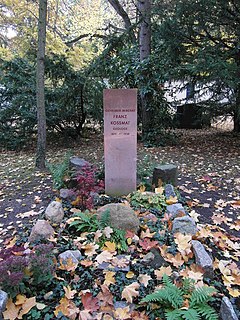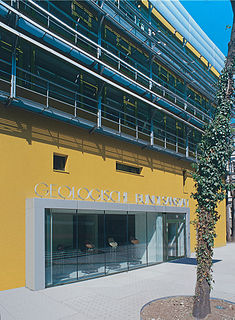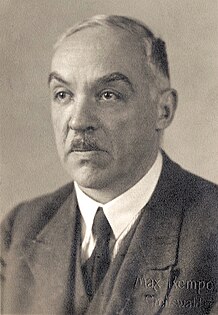Related Research Articles

Steglitz-Zehlendorf is the sixth borough of Berlin, formed in Berlin's 2001 administrative reform by merging the former boroughs of Steglitz and Zehlendorf.

Albrecht Penck was a German geographer and geologist and the father of Walther Penck.

The Berlin-Brandenburg capital region is one of the most prolific centers of higher education and research in the world. It is the largest concentration of universities and colleges in Germany. The city has four public research universities and 27 private, professional and technical colleges (Hochschulen), offering a wide range of disciplines. Access to the German university system is tuition free.

The Kiel Institute for the World Economy is an independent, non-profit economic research institute and think tank based in Kiel, Germany. In 2017, it was ranked as one of the top 50 most influential think tanks in the world and was also ranked in the top 15 in the world for economic policy specifically. German business newspaper, Handelsblatt, referred to the Institute as "Germany's most influential economic think tank", while Die Welt, stated that "The best economists in the world are in Kiel".

Otto Max Johannes Jaekel was a German paleontologist and geologist.

Werner Ernst Martin Janensch was a German paleontologist and geologist.

Franz Kossmat was an Austrian-German geologist, for twenty years the director of the Geological Survey of Saxony under both the kingdom and the subsequent German Republic.

Josef Felix Pompeckj was a German paleontologist and geologist.
Georg Adolf Otto Wüst was a German oceanographer. His pioneering work on the Atlantic Ocean provided a new view of the motions of water masses between the northern and southern hemispheres and the first evidence of the concentration of water mass spreading in western boundary currents.

The Trossingen Formation, formerly the Knollenmergel, is a geological formation in Germany and Switzerland. It dates back to the late Norian-Rhaetian.
The Karl-Scheel-Preis is an award given annually by the Physikalische Gesellschaft zu Berlin, a regional association of the Deutsche Physikalische Gesellschaft, for outstanding scientific work. The prize was established through an endowment by the German physicist Karl Scheel and his wife Melida. Recipients are awarded with the Karl-Scheel Medal and 5.000 Euros. The Karl-Scheel Medal in bronze was designed by the German sculptor Richard Scheibe and has a diameter of 12 cm.
Eberhard Fraas was a German scientist, geologist and paleontologist. He worked as a curator at the Stuttgarter Naturaliensammlung and discovered the dinosaurs of the Tendaguru formation in then German East Africa. The dinosaur Efraasia is named after him.

The Geological Survey of Austria in Vienna is a subordinate agency of the Austrian Federal Ministry for Science and Research and is the central point for information and advice in the field of earth sciences for the Republic of Austria. The most important product of the GBA is a range of geological maps. These appear in various scales both as map series and as regional maps. They form the basis for responses to questions in many areas of business and also for research. The GBA is located in the district of Landstraße in Vienna.
Gebrüder Borntraeger Verlagsbuchhandlung is a scientific publisher covering the fields of Botany, Earth and Environmental Sciences.

Sergius Nikolajewitsch von Bubnoff was a geologist and geotechnical engineer with Germano-Baltic ancestry who made important contributions to the rebuilding of geological research in East Germany after World War II. Starting in 1922, he was a professor at the University of Breslau. In 1929 he became a professor at the University of Greifswald and in 1950, he started his professorship at the Humboldt-University of Berlin. The Bubnoff unit, which is the unit of measure for the speed of geological processes, is named after him.
Günter Dietrich was a German oceanographer. He was the first to describe the Agulhas Current in detail, he provided essential contributions to the understanding of bottom water exchange in the North Atlantic and he shaped marine research in Germany after World War II.
Johannes Hallmann is a German agricultural scientist of phytomedicine. He is a scientific adviser at the Julius Kühn-Institut, the Federal Research Institute for Cultivated Plants, the Institute for Epidemiology and Pathogen Diagnostics in Münster, the University Professor for Nematology and the President of the German Phytomedicine Society.

Sunhild Kleingärtner is a German historian and archaeologist, specialising in maritime history and maritime archaeology.
The Institut für Meereskunde in Kiel, Germany, existed from April 1, 1937 to January 1, 2004. It was an essential element of the long history of marine sciences in Kiel. This history started with the work of Samuel Reyher published in 1697 and is today continued within the GEOMAR Helmholtz Centre for Ocean Research Kiel.

The Sachrang Formation or "Posidonienschiefer" Formation is a geological formation of southwestern Germany, northern Switzerland, northwestern Austria, southeast Luxembourg and the Netherlands, that spans about 3 million years during the Early Jurassic period. It is known for its detailed fossils, especially sea fauna, listed below. Composed mostly by black shale, the formation is a Lagerstätte, where fossils show exceptional preservation, with a thickness that varies from about 1 m to about 40 m on the Rhine level, being on the main quarry at Holzmaden between 5 and 14 m. Some of the preserved material has been transformed into fossil hydrocarbon Jet, specially wood remains, used for jewelry. The exceptional preservation seen on the Posidonia Shale has been studied since the late 1800s, finding that a cocktail of chemical and environmental factors let to such an impressive conservation of the marine fauna. The most common theory is the changes on the oxygen level, where the different anoxic events of the Toarcian left oxygen-depleted bottom waters, with the biota dying and falling to the bottom without any predator able to eat the dead bodies.
References
Departmental History Webpage by Hubert Miller <webpage now defunct>
List mentioning correspondence with Weyl
Costa Rica Guides: Mountains and Volcanos
Der Nationalsozialismus und Lateinamerika by Sandra Carreras